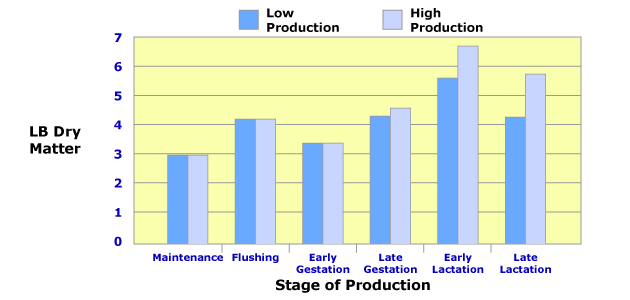Previous Page | Right click this page to print.
Dry Matter Intake
Dry matter intake. How much feed can a ewe consume? Or any sheep? What’s a good ballpark figure? 2-3% of their body weight. Okay. And that’s kind of close, sheep can eat a little bit more. But if you look at roughage consumption at the same level per unit of metabolic size, it's going to be similar to cattle, but when you express it as a percent of body weight, it’s going to be somewhat higher. But if you take everything back to metabolic size, they’re going to be very much the same. But if you do it on a basis of body weight as is, then it’s going to be somewhat higher, but 2-3%, depending upon stage of production, probably closer to 3% in most cases with sheep. Lambs it can range anywhere, in the lighter lambs, from about 4.3% of their body weight at 66 lbs, when they get up to a heavier weight, closer to slaughter, it's about 3.5% dry matter intake. With ewes, maintenance about 2% and then anywhere from 3.5% plus when we get into lactation because this is going to be very much dependent upon level of production. Ewes that are nursing, suckling twins, it is going to be 4.5-5%, those with singles, it is going to be closer to that 3.5%. So that 150 lb ewe at 4% of her body weight, she’s going to be eating about 6 lbs of dry matter per day during lactation.
If we look at dry matter intakes and this is from the NRC requirements for ewes and for the various stages of production and what we do in sheep, we look at, we have two levels of production, we have low production and high production.
Dry Matter Intake for a 176 lb Ewe

A low producing ewe is a ewe that is going to give birth to a less than 150% lamb crop, high producing ewes are going to be 180-225%, that’s how they make that distinction. So, of course, no difference in requirements from the standpoint of dry matter intake in maintenance, flushing, early gestation. We do see a slight increase in late gestation, definitely for early lactation and during late lactation. We’ll be looking at this similar table when we go through energy, protein, vitamins and minerals so I just want to point this out. How do you base your productivity of your ewe flock so you know whether you have high producing or low producing sheep? Well, I guess one of the things you could use is flock history. If you have a flock of sheep that are normally high producing sheep, then you’d formulate on the high production side and if they were low, you’d go on the low. In situations where you have a mix in a flock, you could go in and do real-time ultrasound, count fetuses and then sort and feed those ewes that are carrying multiple fetuses, feed them according to the high production and feed the others according to the low production.
Previous Page | Right click this page to print.